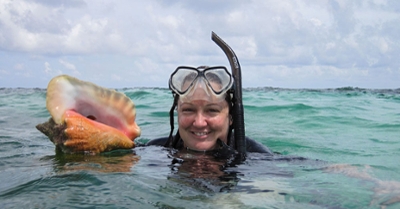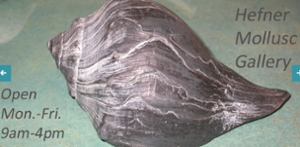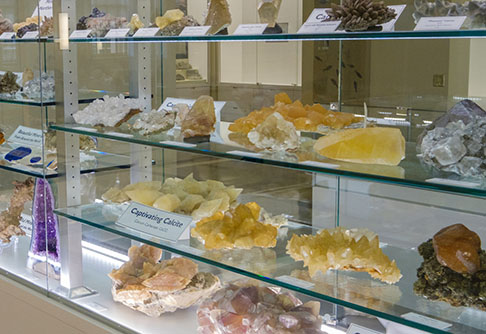

Shellfish graveyards offer glimpse of ocean's pristine past
By Susan Meikle, university news and communications, with Carrie Tyler, geology and environmental earth sciences, and the Florida Museum of Natural History

Tyler and Kowalewski collected samples from 51 sites off the coast of North Carolina by dredging the shellfish graveyards at the bottom of the ocean.
The shells of dead mollusks offer a treasure trove of information about the state of oceans over thousands of years.
A new study by Miami University paleontologist Carrie Tyler and principal investigator Michal Kowalewski of the Florida Museum of Natural History shows that these shellfish graveyards can record patterns in the diversity and distribution of marine animals with surprising accuracy.
Because mollusks — such as conchs, oysters, snails and mussels — are abundant and often have sturdy shells, their remains litter much of the Earth’s sea floor.
Marine time machines
“You can think of these fossils as marine time machines that can unveil bygone habitats that existed before humans altered them,” said Kowalewski, who is the Jon L. and Beverly A. Thompson Chair of Invertebrate Paleontology at the University of Florida.
Collecting data from the shells of dead mollusks is a low-impact way of glimpsing how oceans looked before pollution, habitat loss, acidification and explosive algae growth threatened marine life worldwide, Kowalewski said.

Dredged material, including live mollusks and fossil shells.
Many scientists have questioned whether mollusks alone can provide insights into entire ecosystems. Currents and storms can carry organisms’ remains away, while others are fragmented, destroyed or completely absent from the fossil record. Also, shell graveyards are often a mix of specimens from many centuries.
“The remains that do accumulate only represent part of the whole ecosystem,” said Tyler, the study’s lead author. “These and other factors can create bias in the fossil record, making comparisons between modern and fossil ecosystems suspect.”
To measure the mollusks' ability to record biodiversity, Tyler and Kowalewski surveyed living and dead marine animals at 51 sites off the coast of North Carolina, selecting spots that differed in environmental conditions and the kinds of species they hosted.
They tested whether changes in diversity from place to place were accurately recorded by the newly-forming fossil record. They also assessed whether mollusks could reflect these ecosystemwide changes.
Understanding marine diversity critical to protecting ocean health
They found that live and dead mollusks accurately recorded spatial diversity patterns in both living and fossil communities of marine bottom-dwelling organisms.
Understanding how the diversity of species changes within habitats and from site to site across the sea floor is crucial for effectively planning protected marine areas and coastal resource management, Kowalewski said. It is also a part of an increased effort to approach ecosystem conservation more broadly, focusing not only on the vulnerability of individual species but also on how species congregate within and across habitats.
“Whether mollusks can provide insights into an ecosystem’s more mobile animals, such as fish, remains unclear. But regardless of how much mollusks can tell us about fish, turtles or mammals, understanding marine invertebrate biodiversity is critical to restoring and protecting ocean health,” Tyler said.
Their study was published this month in Proceedings of the Royal Society B.
Read more about the study on the Florida Museum of Natural History website.
About Carrie Tyler

Carrie Tyler
Tyler conducted the fieldwork for this study while she was a postdoctoral researcher in Kowaleski’s laboratory.
She is now assistant professor of geology and environmental earth sciences at Miami.
She recently received funding from the National Science Foundation for two other projects:
- $70,240 from NSF, as co-principal investigator with scientists at the California Academy of Sciences (a museum and scientific institution that is among the largest museums of natural history in the world) to research the ecosystems and food web dynamics of the ancient Tethys Sea.
- $112,573 from NSF, as lead principal investigator with Kowalewski at the Florida Museum of Natural History on the history of predation of echinoids (such as sea urchins and sand dollars). Read more about this project on the OARS blog, “Paleontologist explores the ecology and evolution of echinoids.”
Tyler is currently a mentor to two undergraduate research students, one graduate student and one combined B.S./M.S. degree student.
She received her doctorate from Virginia Tech in 2012 and was a postdoctoral researcher with Kowalewski at the Florida Museum of Natural History from 2012-2014. She served as visiting assistant professor at Colorado College in 2014 before joining Miami in 2015.
![]()
Something extra:
 Tyler explains about her research on fossils from the Tethys sea:
Tyler explains about her research on fossils from the Tethys sea:
"The circular network is the first marine food web from the Late Cretaceous Period (about 66-72 million years ago) in the Tethys Sea. The nodes (circles) are guilds, which are groups of species that perform the same function in an ecosystem. Species within those guilds have the potential for trophic interactions (predators or prey).
The lines connecting the nodes represent interactions between predators and prey, and highly connected portions within the network, or modules, are color coded.
This network visualization was created from 1,906 species, and has 44 guilds and 205 interactions. We are creating Tethyan food web visualizations for each geologic stage of the Mesozoic to examine how ecosystem structure changes through time during a time of proposed increasing predation intensity."


